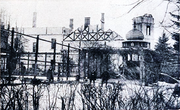Berhometh Castle
Berhometh Castle ( Romanian Castelul Berhomet ) was the seat of the Count Vasilko von Serecki family in Berhometh , in the Duchy of Bukovina . The castle was looted by the Russian army during the First World War in 1915 and destroyed by torching.
history
The construction of the castle can be dated to the 1940s, when Baron Jordaki Wassilko von Serecki began to expand his manor house. His son Alexander completed the construction and had the tower built in the 80s of that century. At the beginning of his second term (1888–1991), as governor of Bukovina, he ensured the start of the electrification of Chernivtsi and the region. His headquarters in Berhometh was one of the first places outside the capital to benefit from it. A large park surrounded the building. The building consisted of several connected parts, the main part, like the tower, had a high pitched roof. The facade was partly designed in the rural half-timbered house style.
The castle and estate was a part of since 1888 Fideikommiss the Wassilko family. When the First World War broke out in 1914, it was the property of the secret council and Bukovinian governor, Count Georg Wassilko von Serecki .
The Wiener Zeitung of February 26, 1915 reported: “In addition to the devastation caused by the Russian Cossack hordes in Bukovina, Berhometh Castle on Sereth, the property of the secret council and Fideikommissowner Georg Wassilko von Serecki, became the property of the Austrians before the arrival of the Austrians , completely cremated by fire set by them. "
Originally, after the initial successes in the war, the Russian General Staff was billeted there. Thereupon the billeting of Russian officers changed, who repeatedly expressed their displeasure about the fact that the owner was not present and that there was not enough provision for their entertainment. Each departing department then took from the valuable furnishings, furniture, pictures, but also money and precious items as well as u. a., the very valuable collection of antlers from self-hunted deer, which caused a sensation in the Vienna hunting exhibition. They also stole the valuable cattle (including 300 Simmental cows), the numerous luxury and farm horses including harness, until the last departments finally found the castle completely looted. During the last passage, the castle and the farm buildings were also set on fire in February 1915.
When the fire was set, Cossacks climbed onto the roof and poured gasoline on it. Cartridges were placed in various places in the castle so that they should explode as soon as the fire spread. The Russian commander justified the order to set fire to the ground by saying that Count Wassilko had created his own regiment of volunteers, which was mistaken for the deputy Nikolaus von Wassilko , who had set up a voluntary Ukrainian Hutsul corps.
When the Russians withdrew in August 1917, after they had completely robbed the famous Putna monastery with the grave of the Moldovan prince Ștefan cel Mare , they again turned their attention to the possessions of the Wassilko family. Since they had plundered and then cremated the Berhometh ancestral castle during the first invasion, the large steam saw and all (rebuilt) farm buildings were torched, as was Mihowa Castle , which belonged to George's mother, the widow of the privy councilor Katharina, née von Flondor , to the ground equalized. Since the village of Berhometh was largely a victim of the flames, there was now only one larger building on the entire five square miles area of the Wassilko Fideikommissherrschaft , the apartment of the forest manager.
The castle was not rebuilt, but rather had several villa-like buildings built in the huge castle park, which has been partially preserved to this day. The family cemetery also still exists.
See also
Individual evidence
- ↑ Wiener Bilder, No. 10, from Sunday, March 7, 1915, p. 7
- ↑ Wiener Zeitung (Abendpost) No. 46, from Friday, February 26, 1915, p. 1 f.
- ↑ (News) World, sheet No. 47, from Saturday, February 27, 1915, p. 3
- ↑ [1] Innsbrucker Nachrichten No. 138 (evening edition), from Wednesday, March 17, 1915, p. 1
- ↑ Neue Freie Presse No. 19038 (Abendblatt), from Wednesday, August 22, 1917, p. 3
Web links
Coordinates: 48 ° 10 ′ 5 ″ N , 25 ° 19 ′ 17 ″ E




